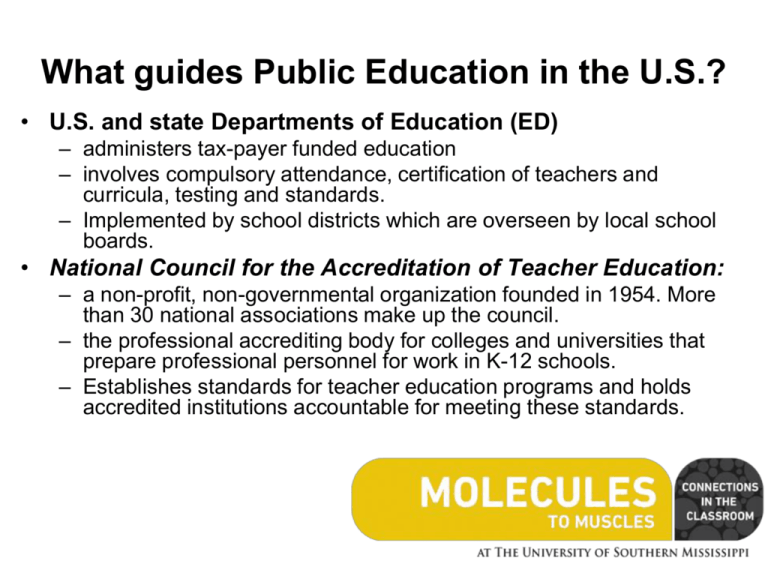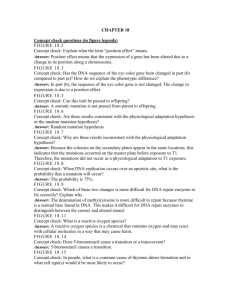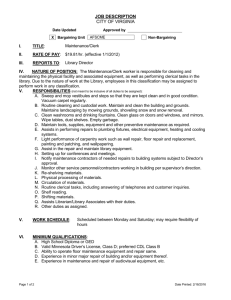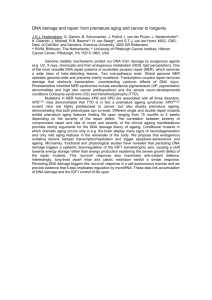UV_sensitive_yeast
advertisement

What guides Public Education in the U.S.? • U.S. and state Departments of Education (ED) – administers tax-payer funded education – involves compulsory attendance, certification of teachers and curricula, testing and standards. – Implemented by school districts which are overseen by local school boards. • National Council for the Accreditation of Teacher Education: – a non-profit, non-governmental organization founded in 1954. More than 30 national associations make up the council. – the professional accrediting body for colleges and universities that prepare professional personnel for work in K-12 schools. – Establishes standards for teacher education programs and holds accredited institutions accountable for meeting these standards. Research-based Science Curricula Catalyzed by the Space Race, Congress passed the National Defense Education Act in 1958. The NSF established programs to fund state-of-theart high school textbooks with emphasis on basic principles and the assumption that students learn best by actually performing experiments rather than memorizing facts. Active Physics Connected Math What guides Public Education in the U.S.? • Civil Rights Act – July 2, 1964 outlawed major forms of discrimination against blacks and women. • Elementary and Secondary Education Act – enacted April 11, 1965; part of President Lyndon B. Johnson's "War on Poverty" and has been the most far-reaching federal legislation affecting education ever passed by Congress. The act is an extensive statute that funds primary and secondary education, while explicitly forbidding the establishment of a national curriculum. It is now called No Child Left Behind: proposed by 43rd President Bush and shepherded through the Senate by coauthor Ted Kennedy. Received overwhelming bipartisan support in Congress for standards-based education reform. What guides Public Education in the U.S.? • National Assessment of Educational Progress (NAEP) – Planning began in 1964 with a grant from the Carnegie Corporation. – The first voluntary national assessments of mathematics, reading, science, writing, the arts, civics, economics, geography, and U.S. history were held in 1969. – NAEP reports become part of "The Nation's Report Card." – Congress created the 26-member Governing Board in 1988. Objectives Ralph Tyler influenced the underlying policy of the Elementary and Secondary Education Act of 1965. Tyler chaired the committee that eventually developed the National Assessment of Educational Progress (NAEP). Three types: performance, instructional, and learning. • • Gronlund, Stating Objectives for Classroom Instruction, 3rd ed., 1985). http://edtech.tennessee.edu/~bobannon/writing_objectives.html Photo from The Phi Delta Kappan Vol. 55, No. 1, Sep., 1973 Objectives: the A,B,C, & D Heinich et al (2002) suggest that well written objectives have four parts. • A stands for Audience • B represents Behavior : measurable, observable, specific. Verbs such as know, understand, comprehend, and appreciate are difficult to measure • C stands for Condition • D for Degree of Accuracy http://itc.utk.edu/~bobannon/writing_objectives.html • • Original image by Karin Kirk, SERC-Carleton College. Originally uploaded in Cutting Edge: Affective Domain. What guides Public Education in the U.S.? • Disabilities Act – Rehabilitation Act of 1973, amended 1978, 1986, Americans with Disabilities Act (ADA), signed into law by 41st President Bush on July 26, 1990. • National Science Education Standards – produced by the National Research Council in 1995 and published in 1996. The Standards were the result of four years of work by 22 scientific and science education societies and over 18,000 individual contributors. 6 aspects: teaching, professional development, assessment, content, programs, and systems. • National Educational Technology Standards – first published in 1998 by the International Society for Technology in Education. Experiential Learning Theory Learning Styles, David Kolb • If you are an AUDITORY learner, you may wish to use tapes. – Tape lectures to help you fill in the gaps in your notes. But do listen and take notes, reviewing notes frequently. Sit where you can hear well. After you have read something, summarize it and recite it aloud. • If you are a VISUAL learner, look at all study materials. – Use charts, maps, filmstrips, notes and flashcards. Practice visualizing or picturing words/concepts in your head. Write out everything for frequent and quick visual review. • If you are a TACTILE learner, trace words as you are saying them. – Write facts several times. Taking notes is very important. Make study sheets. Penn State: http://www.personal.psu.edu/bxb11/LSI/LSI.htm Howard Gardner’s Multiple Intelligences • Much acclaimed Harvard professor and adjunct professor of neurology at the Boston University School of Medicine. • Research on normal and gifted students and adults with brain damage. • Concluded there were eight different intelligences that individuals use to perceive and understand the world: Visual-Spatial, Bodily-Kinesthetic, Musical, Interpersonal, Intrapersonal, Linguistic, LogicalMathematical, Naturalistic Constructivist Learning Theory Learning is a process you do, not a process that is done to you. Let’s experience a lesson based on Constructivist Learning Theory in the 5E format! Yeast is a Model Organism for Teaching • Eukaryotic and non-pathogenic – Easy to use because sterility is not such an issue in a teaching lab; 30˚ C or room temperature • Visible with light microscope; some phenotypes = genotype! • The GENE Project at Kansas State developed a tremendous resources for teachers available on web. • Carolina Biological and Ward’s Scientific provide teacher-friendly kits for classroom use. • Saccharomyces cerevisiae wild type strain has DNA repair mechanisms that protect against UV radiation. • Saccharomyces cerevisiae mutant DNA repair UV-sensitive strain, lacks DNA repair enzymes. • Note: Cells of all types have evolved mechanisms for repairing DNA damage. Even though many placental mammals can photoreactivate, this particular mechanism is not active in humans. Engage Interest! Prior Knowledge? Ask a question! Explore • Design and conduct an experiment using UV light chambers and UV sensitive yeast. • You may work alone, but encouraged to work in groups. • Sunscreen, makeup, etc. will be available, but you are strongly encouraged to bring your own test materials. • Form a hypothesis. • Design a controlled experiment to test the hypothesis. Explore Photographs by Sherry Herron, BSCS Keys to Science Goal is to evenly distribute a consistent number of cells so that individual colonies can be counted; not so many that the colonies form a “lawn”. Use aseptic techniques. Photographs by Sherry Herron, BSCS Keys to Science 2X Serial Dilution: Label 4 test tubes A B 2 mL C 1 mL 1 mL D 1 mL Inoculate water in tube A with yeast stab. A B → 1 mL C D →1 mL →1 mL Select the tube that is “just barely turbid”: ~ 1,000,000 (106) cells/mL. 10X Serial Dilution: Label 3 more tubes AA BB CC 0.9 mL 0.9 mL 0.9 mL AA BB CC → 0.1 mL → 0.1 m → 0.1 mL* *Take 0.1 mL from tube that is “just barely turbid” and add to AA Inoculate plates Label treatment on the underside of the plates. Inoculate with 0.1 m from tube CC. Photographs by Sherry Herron, BSCS Keys to Science Spread the cells Use a disposable sterile spreader or a metal spreader. A metal spreader is sterilized by dipping it into a beaker of alcohol and then holding it in a flame. The spreader should be cooled by touching it to the edge of the agar before using it to spread the cells. Photographs by Sherry Herron, BSCS Keys to Science Apply the treatment Photographs by Sherry Herron, BSCS Keys to Science Expose Explain • Students count colonies and analyze data • Students give informal presentations to share results • Teacher introduces scientific terms and explanations. Depends on the concept you want students to understand. Physical science: electromagnetic spectrum,Chapman Equations Life science: cancers, DNA and DNA repair mechanisms, adaptations Earth science: atmosphere STS topics: SPF ratings, ground-level vs atmospheric ozone, global warming vs ozone hole. Explanation Students generate an explanation of the concept (lab report, short summary, oral explanation, etc.). Teachers introduce scientific terms and explanations. Depends on the concept you want students to understand. The Electromagnetic Spectrum The Chapman Equations Skin cancers Stratosphere DNA repair mechanisms Human adaptations: skin color STS topics: SPF ratings, ground-level vs atmospheric ozone, global warming vs ozone hole. Explain Saccharomyces cerevisiae strain G948-1C/U, mutant DNA repair • UV-sensitive yeast lacks 3 DNA repair enzymes that are functional in the wild type – 2 used in excision repair – 1 used in photo-reactivation (the energy of visible light is used to repair mutations; most efficient mechanism) Note: Cells of all types have evolved mechanisms for repairing DNA damage. Even though many placental mammals can photoreactivate, this particular mechanism is not active in humans. Explain http://amazing-space.stsci.edu/resources/explorations/light/ems-frames.html UVA /Near: 320-400 nm penetrates the deepest; causes skin cancer and cataracts UVB /Far: 280-320 nm most is absorbed by ozone layer UVC / Extreme: 1-280 nm all is absorbed by ozone layer Ozone layer/ hole 17- 25 km (~10 - 20 mi) up Air is densest; weather; UVA penetrates The Chapman Reactions Sydney Chapman, an English mathematician and astronomer (1888 - 1970) published 1930: • Ozone is created when UV radiation dissociates oxygen molecules (O2) to atomic oxygen (O). O2 + hv -> O + O (1/v = wavelength < ~ 240 nm) • O then combines with other oxygen molecules: O + O2 -> O3 • Ozone can reform resulting with no net loss: O3 + hv -> O2 + O O + O2 -> O3 • Ozone can also be destroyed: O + O3 -> O2 + O2 The Ozone Hole • 1974: Molina, Crutzen, and Rowland explained the chemical mechanisms that affect the thickness of the ozone layer. • 1985: Ozone “hole” over Halley Bay, Antarctica first described • © 1998. Centre for Atmospheric Science, Cambridge University, UK. Ozone Depleters Chlorofluorocarbons (CFCs) are converted to free radicals by UV radiation • used in refrigeration systems, air conditioners, aerosols, solvents and in the production of some types of packaging Any halogen (halons) including Teflon, carbon tetrachloride, methyl chloroform, nitrogen oxides from aircraft emissions. • have long residence time (stable, inert, not water-soluble; don’t rain out!) National Weather Service and the EPA rates the risk of UV exposure from 0 (min) – 15 (very high). Sun Protection Factor Recommended SPF Skin Type 1 hr 2 hr 3 hr 4 hr 5+ hr Very Fair Fair /Sensitive Fair Medium Dark 15 15 15 8 4 30 15 15 8 8 30 30 15 15 8 45 30 30 15 15 45 45 30 30 15 • proposed by the Austrian scientist Franz Greiter • indicates the length of time you can stay in the sun without burning based on your skin complexion The UN Montreal Protocol • 1st signed in 1987 • stipulates that the production and consumption of compounds that deplete ozone are to be phased out by 2000 (2005 for methyl chloroform). • The World Meteorological Organization estimated recovery of ozone layer by 2045 (Reports #25, #37), but recent investigations suggest the problem is worse than anticipated. 1995: Nobel Prize in Chemistry Awarded jointly to Paul J. Crutzen, Mario J. Molina and F. Sherwood Rowland "for their work in atmospheric chemistry, particularly concerning the formation and decomposition of ozone.These three researchers have contributed to our salvation from a global environmental problem that could have catastrophic consequences.” http://www.nobelprize.org/nobel_prizes/che mistry/laureates/1995/ Malignant Melanoma Images Courtesy of the American Academy of Dermatology http://www.melanomacenter.org/basics/statistics.html Melanoma • Begins in melanocytes, the pigment cells located in the basal layer • 3 or more blistering sunburns before the age of 20 leads to a 5 X greater risk • most common cancer among people 25 to 29 years old • Malignant: kills about 100,000 people worldwide annually • Since 1981, the incidence of melanoma has increased an average of 7% per year to a rate of 14.3 / 100,000 in 1997 Skin Color • All people have about the same number of melanocytes (melanin producing cells). • Inheritance of skin color is multigenic and expressed in an additive manner. • Skin color depends on how much melanin (the pigment) is made and carried to the upper layers of the skin. • Exposure to UV rays causes even more melanin to be produced in order to protect DNA. • There isn’t just one pigment: – brown/black type: eumelanin – amber/red type: pheomelanin (contains sulfur) Human Adaptation The skin colors of indigenous human populations reflect the natural selection process for healthy living in the various geographical regions of Earth. • The final step of Vitamin D (calciferol) biosynthesis occurs in the epidermis upon exposure to UV rays. Vitamin D promotes calcium absorption and bone formation • Light skin allows for greater penetration of UV rays. • Darker skin protects against skin cancer: melanin absorbs UV rays. DNA mutations include Thymine Dimers Covalent links between two adjacent thymine bases within a strand of DNA. Disrupts replication and transcription http://www.aw-bc.com/mathews/ch25/fi25p9.htm DNA Repair Mechanisms • • • • Photoreactivation using FADH Nucleotide excision repair Base excision repair Recombinational repair DNA Repair • UT-Ds own, Dr. Claude Rupert, did seminal research on light-activated DNA repair systems (photoreactivation). • http://www.dnaftb.org/ dnaftb/28/concept/ind ex.html Thymine Dimer Repair • Dr. Richard Setlow also researched thymine dimer repair. • http://www.dnaftb.o rg/dnaftb/28/conce pt/index.html Excision repair of thymine dimers by the UvrABC excinuclease of E. coli. Adapted from A. Sancar and J. E. Hearst, Science (1993) 259:1415-1420. © 1993 AAAS. http://www.awbc.com/mathews/ch25/fi25p9.htm Base excision repair of thymine dimers http://www.aw-bc.com/mathews/ch25/fi25p9.htm Recombinational repair http://www.aw-bc.com/mathews/ch25/fi25p9.htm Resources • The GENE Project from Kansas State University. Dr. Tom Manney http://www.k-state.edu/gene/ • Yeast Experiment Materials Available From Carolina Biological Supply Co. To order call 1-800-334-5551, or visit their web site http://www.carolina.com • UV sensitive yeast: G948-1C/U mutant is defective in excision repair, error prone repair and photoreactivation, and uracil requiring Instructional Model based on Constructivist Learning Theory 1. Engage: Instruction engages students with questions and creates curiosity. The teacher assesses students’ prior knowledge about the content. 2. Explore: Teacher provides situation and gives directions for exploration (i.e. lab experiment or activity). Teacher provides time for students to complete the work. Students make predictions and gather data. 3. Explain: The teacher encourages the learners’ to explain what they learned. The teacher introduces new terms, ideas and explanations. 4. Elaborate: The teacher encourages learners to apply the new knowledge to investigate further and helps students to practice the new knowledge. 5. Evaluate: The teacher observes students performance to assess their understanding. Students are expected to apply their new knowledge and skills as they perform. (Bybee et al. 2006) Constructivist teaching techniques… • • • • • • • • Demonstrations Laboratories Field Experience Guided Inquiry Activities Modeling Research Projects Issue-Centered Problems Computer Simulations • Reading, writing, speaking • Group discussion • Debates • Cooperative Learning • Data analysis • Audiovisuals Ask GOOD questions! • Description: – Is this typical? • Investigation: – What causes it to happen? • Prediction: – What are the future risks, benefits, or consequences? • Evidence: – Are there any other explanations? Assessment (other than multiple choice) • • • • • • Essay Constructed response Research papers Project reports Lab reports Self assessment and journals • Performance-based • Lab practicums • • • • Oral reports Research projects Observation Peer group assessment • Construction of models • Simulations • Portfolios Presentations in the hallway Resources • • • • • http://www.agpa.uakron.edu/ http://www.dnalc.org/ http://learn.genetics.utah.edu/ http://teach.gene http://learningcenter.nsta.org/default.aspxti cs.utah.edu/ You do RESEARCH! • PLEASE share your knowledge, skills, and enthusiasm for science. BE A MENTOR!!! Intel International Science and Engineering Fair (ISEF) •administered for over 60 years by Science Service, www.sciserv.org, one of the most respected non-profit organizations advancing the cause of science. •Intel Corp commits more than $3 million annually to promote the competition. •Intel ISEF finalists come from a field of more than 65,000 students who participated in more than 550 Intel ISEF-affiliated science fairs around the world. •More than 1,500 young competitors, grades 9-12, come from 65 countries, regions, and territories. ISEF Stats: •Special awards worth more than $1.5 million (including scholarships, internships, field trips, and lab equipment) are provided by nearly 80 sponsors. •Over 800 prizes and more than $4 million in awards and scholarships given. •Top Prize: Intel Foundation Young Scientist Award, given to three finalists, each receives a $50,000 college scholarship •2008 Winner Natalie Saranga Omattage from the Mississippi School for Mathematics and Science developed a biosensor capable of detecting food contaminants. Natalie Omattage: a 2008 Grand Prize Winner ISEF Stats: • 18 Best of Category prizes go to the top-scoring student in each project category. Each student receives a $5,000 scholarship and a computer, with the student’s school and fair director receiving $1,000 for science and math education. •Grand awards are given for 1st ($3,000), 2nd ($1,500), 3rd ($1,000), and 4th ($500) place projects in each category. http://www.societyforscience.org/isef/ Let’s check it out! Mississippi Science and Engineering Fair Each year… • >7000 students in MS participate in regional competitions (7 in MS). • >500 high school students participate at the state level. • >25 winners participate at International SEF • MISSISSIPPI STUDENTS ALWAYS DO WELL Nuts and Bolts • Prepare – Plan your project with a mentor – Get approval. Use ISEF Rules Wizard. – Conduct research – Prepare presentation • School must register. Teacher submits abstract forms. • Students compete.





